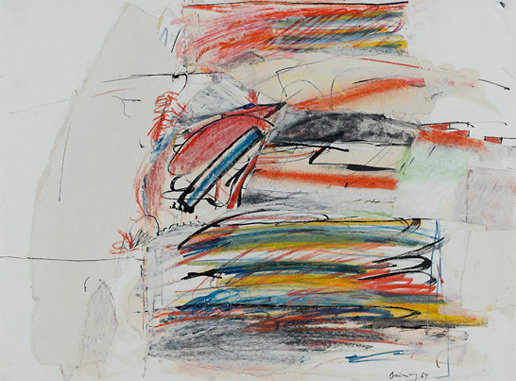German Informel
dal 20/2/2009 al 31/5/2009
Segnalato da
Peter Bruning
Emil Cimiotti
Karl Fred Dahmen
K.O. Gotz
Gerhard Hoehme
Bernard Schultze
Emil Schumacher
K.R.H. Sonderborg
Fred Thieler
Hann Trier
Wilhelm Wessel
20/2/2009
German Informel
Staatsgalerie, Stuttgart
Drawings, prints, portfolios and illustrated books - from the collection of Prints and Drawings. The works by Peter Bruning, Emil Cimiotti, Karl Fred Dahmen, K.O. Gotz, Gerhard Hoehme, Bernard Schultze, Emil Schumacher, K.R.H. Sonderborg, Fred Thieler, Hann Trier and Wilhelm Wessel to be exhibited in the Graphik-Kabinett - the exhibition gallery of the Department of Prints, Drawings and Photographs - will provide a detailed overview of "German Informel", thus enhancing the paintings of this period currently on view on the ground floor of the Alte Staatsgalerie.

From 21 February 2009 for fourteen weeks, the Staatsgalerie will be showing treasures of German Informel – drawings, prints, portfolios and illustrated books – from its collection of Prints and Drawings. The works by Peter Brüning, Emil Cimiotti, Karl Fred Dahmen, K.O. Götz, Gerhard Hoehme, Bernard Schultze, Emil Schumacher, K.R.H. Sonderborg, Fred Thieler, Hann Trier and Wilhelm Wessel to be exhibited in the Graphik-Kabinett – the exhibition gallery of the Department of Prints, Drawings and Photographs – will provide a detailed overview of "German Informel", thus enhancing the paintings of this period currently on view on the ground floor of the Alte Staatsgalerie.
After the traumatic experiences of World War II, at a time when artists were in search of new means of formative expression, Informel (formless art; French: Art Informel) emerged in Paris, initially as a counter movement to Geometric Abstraction. The name is used as a general term for various abstract art currents (Tachisme, Lyrical Abstraction, Art Brut, etc.) and denotes the European counterpart to American Action Painting and Abstract Expressionism.
With a lyrical-abstract sign language often graphically inspired (for example by calligraphy), the process of pictorial invention becomes an interplay between the artist’s subconscious creative gesture and his deliberate act of painting or drawing. The concern is not with chaotic "acting out" on the canvas, as in the case of Action Painting, for example, but with allowing the work to emerge, guided by emotion and spontaneity. The search itself becomes the leitmotif. Constant change and evolution characterize the work’s emergence in the search for the unknown. Emil Schumacher was preoccupied with the seven central themes of form, line, colour, matter, destruction, space and nature, as he demonstrated impressively in the aquatints of the portfolio "Ein Buch mit 7 Siegeln" of 1972. It was here that he remarked: "The form which is life’s prerequisite – the form which contains life – is ›formless‹ and yet form."
However broadly the term Informel is applied, every one of the artists subsumed by it is an individualist and an innovator. Invented signs, colour rhythms, various materials mixed into the paint – all of these techniques served the expression of a special, unique artistic individuality, a personal feeling, intended to draw the beholder closer. It is not the mere picture that is the focus of attention here, but the "event" of perceiving it.
Image: Peter Brüning "Collage", 1964, Staatsgalerie Stuttgart, © VG Bild-Kunst, Bonn 2009
Marketing/Communication
Dr. Beate Wolf Head of Department
Tel. +49 (0)711 47040275 b.wolf@staatsgalerie.de
Veronika Spang
Tel. +49 (0)711 47040274 v.spang@staatsgalerie.de
Sarah Wegenast Tel. +49 (0)711 47040273 s.wegenast@staatsgalerie.de
Staatsgalerie
Konrad-Adenauer-Str. 30 - 32
70173 Stuttgart



